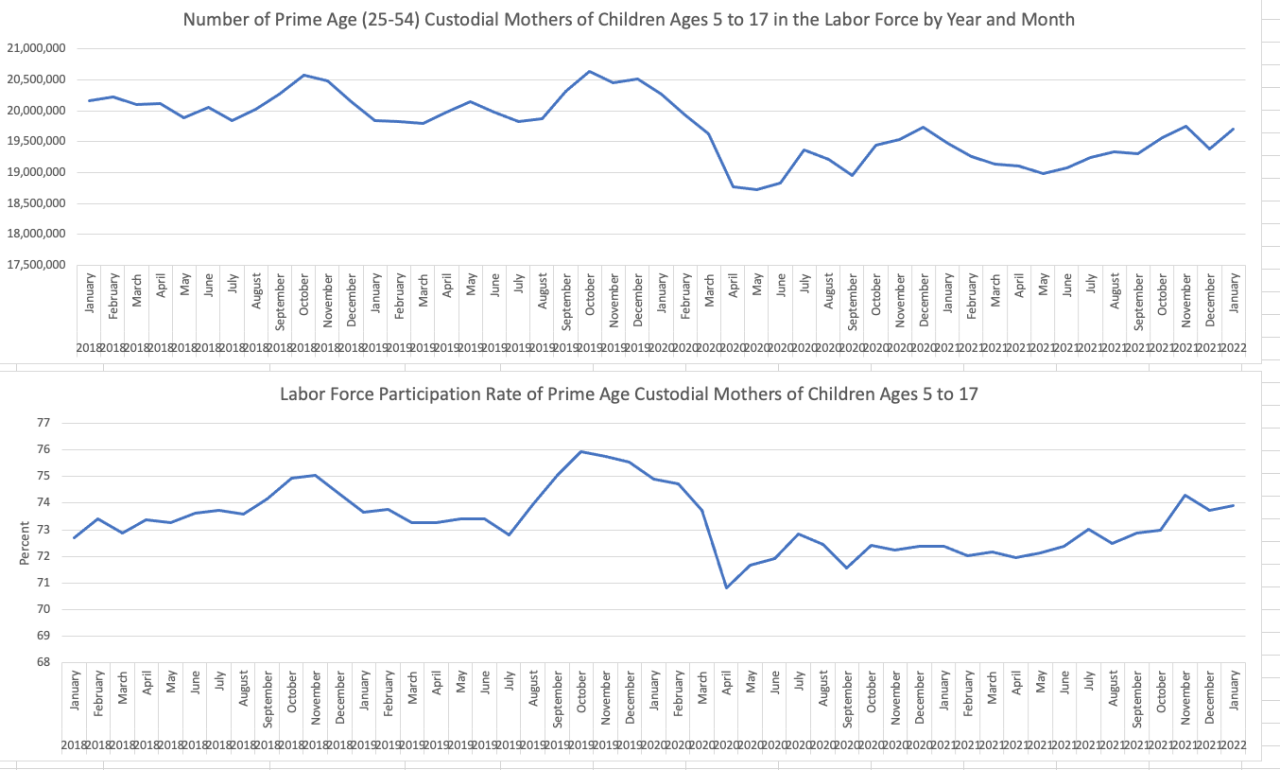CLEVELAND — There has been recovery from the significant hit working mothers took early in the pandemic, but there were still fewer mothers of school-age children in the U.S. labor force in January of 2022 compared to January of 2020.
When it comes to prime-age (25-54) custodial mothers of children aged 5-17, there were 578,251 fewer in the labor force as of January of 2022 than two years prior, according to data from economic researcher Misty Heggeness using the Current Population Survey, U.S. Census Bureau/BLS via IPUMS.

Disruptions to schooling and child care were big hits. For many working moms, the experience has changed them, and many are now demanding more from their professional careers that for years demanded so much of them personally.
"I wake up in the morning, get the kids breakfast and lunches," said Robin Neorr, a working mom of three.
Finding time for herself is rare.
"Hmmm, waiting for it still," she laughed.
Like so many working parents, Neorr knows time is a natural resource more precious than gold, and she says she's found a way to mine more of it: Remote work.
"I want to have a career and I want to be able to make sure my children's needs are met," she said. "And the only thing I can see is to find a remote position."
During the pandemic, she left a job she loved at a university. She says juggling at-home schooling for her and her husband's three kids, at three different schools, while also getting herself to and from work became too much.
"It broke my heart that I had to quit, but I had to do what's best for my family," she said.
Neorr is not alone. Studies show women are increasingly more burned out than men. One in three women considered downshifting their careers last year, compared to one in four the year prior, according to Women in the Workplace study from McKinsey & Company.
"All the moms I know, our mental health is just, really deteriorated," said Neorr.
Balancing paid and unpaid labor has never felt heavier.
"Flexibility is an imperative at this point," said Chandra Sanders with The Mom Project, a digital talent marketplace connecting working mothers to employers who understand their needs.
Sanders said demand has grown exponentially.
"We're at a place where we can no longer separate the human experience from the work experience," she said. "We have to integrate them both."
Sanders, a working mom herself, is the director for RISE at The Mom Project; a free, up-skilling program offering different certifications in six weeks to six months.
"This program is for every mother out there who wants to change her life," said Sanders.
Neorr is finishing up her Google Data Analytics certificate through the RISE program and says every day she gets remote job opportunities sent her way.
"Thirty dollars an hour, 40-hours a week... are you interested in interviewing for this," she said describing one opportunity.
What happens to us is often out of our control, like the pandemic. But mothers, like Neorr, prove that what we learn from it can empower us.
"You've had kids and you think, 'What I graduated from college with is going to be what I'm going to do for the rest of my life,' and I'm not doing that!"
According to a recent survey from Pew Research, 60% of workers with jobs that can be done from home say they'd like to work from home all or most of the time.
Jodi Schulman, vice president of LHH Recruitment Solutions, says it's not a passing trend.
"If companies want to hire top talent they have to be flexible," she said.
Especially, when trying to lure a parent who left the workforce during the pandemic and is now looking to re-enter the labor force under parameters that work best for their families.
Schulman says many companies are adapting to flexible or remote positions and the ones slower to the uptake often miss out on desired candidates who go elsewhere.
However, the Pew Research survey also says most U.S. workers, about 60%, don’t have jobs that can be done from home.
In Northeast Ohio, women make up a majority of the labor force in many of the jobs hardest hit by pandemic restrictions, according to Team NEO's Lost Opportunities report. It also shows three of the top five sectors in the region with high rates of female employment accounted for employment losses of more than 70,000 jobs in 2020. These are jobs that mostly cannot be done remotely, like health care workers, child care providers, restaurant workers and owners, or stylists and salon owners.
According to an analysis from the Center for American Progress, 41% of mothers were sole or primary breadwinners in 2017.
A way to better support mothers in the workplace right now, a recent study from researchers in California pointed to employers providing more opportunities for remote or flexible schedules, improving parental leave policies, and PTO for child care emergencies that doesn't take away from vacation time.
Pre-pandemic problems are outstanding as well, like the gender wage gap.
According to the Lost Opportunities report, women’s wages have improved but women still earned 23% less than men in Northeast Ohio despite working almost half of all the hours worked in the region in 2019.
Download the News 5 Cleveland app now for more stories from us, plus alerts on major news, the latest weather forecast, traffic information and much more. Download now on your Apple device here, and your Android device here.
You can also catch News 5 Cleveland on Roku, Apple TV, Amazon Fire TV, YouTube TV, DIRECTV NOW, Hulu Live and more. We're also on Amazon Alexa devices. Learn more about our streaming options here.





